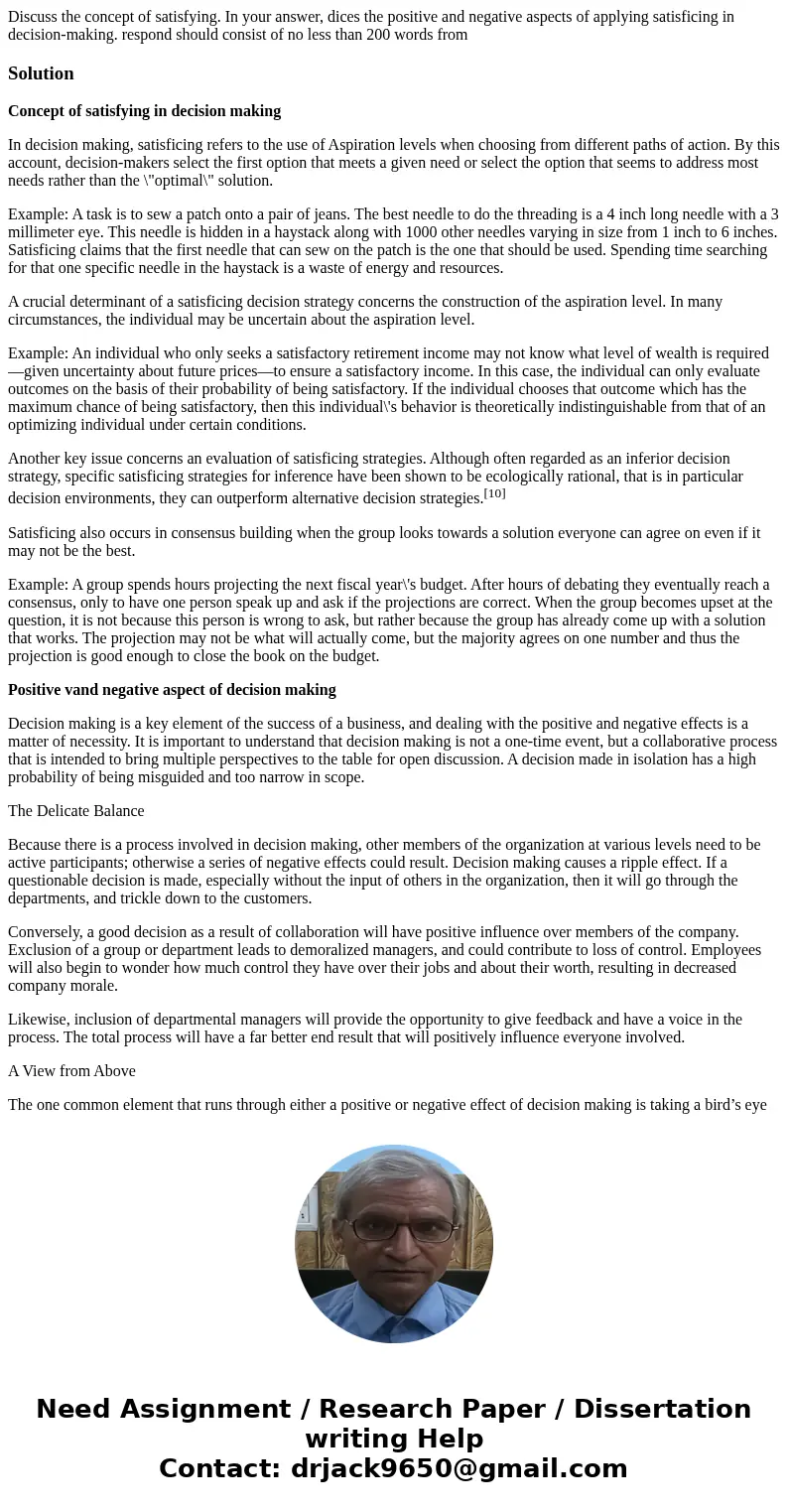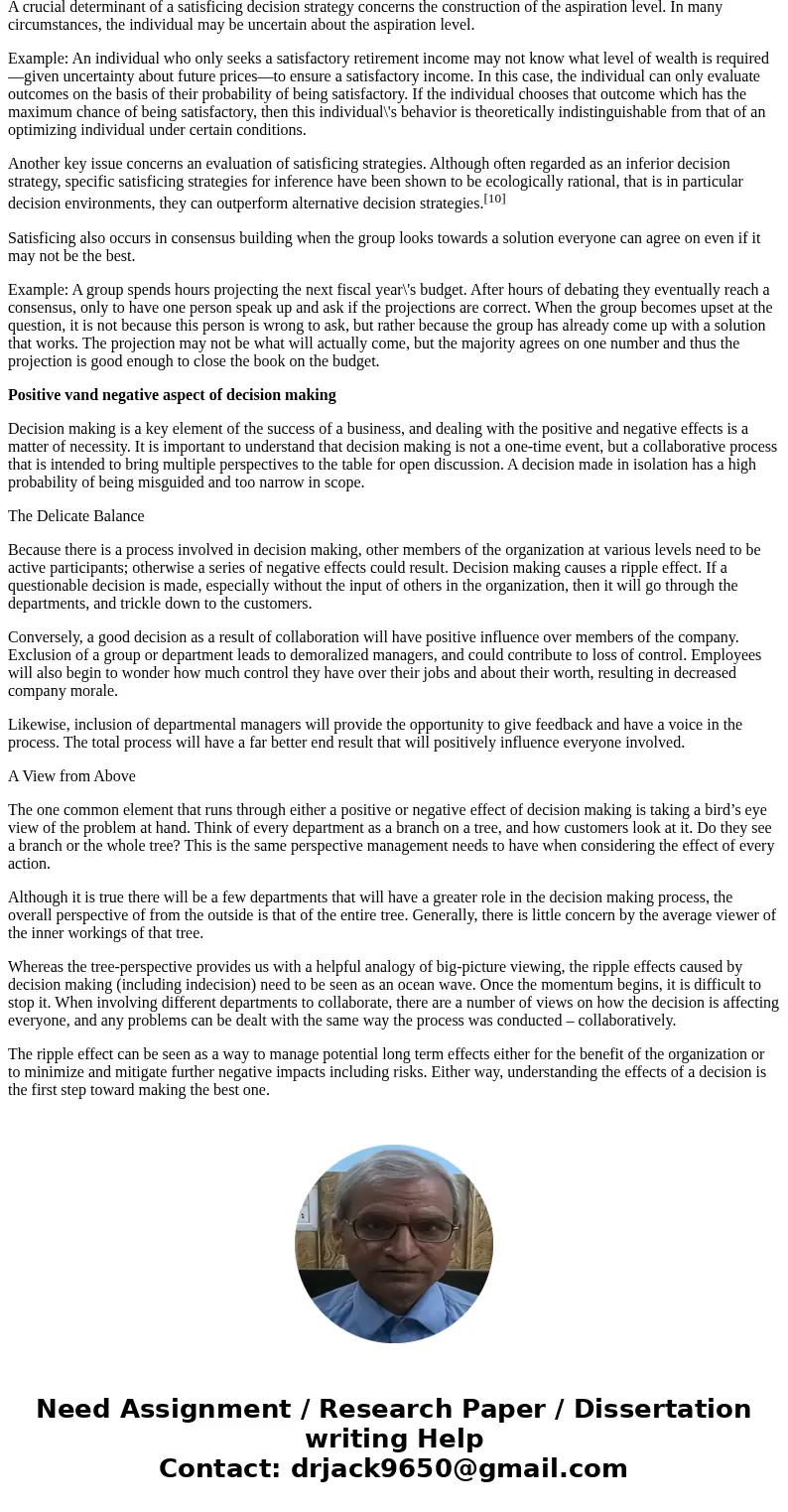Discuss the concept of satisfying In your answer dices the p
Discuss the concept of satisfying. In your answer, dices the positive and negative aspects of applying satisficing in decision-making. respond should consist of no less than 200 words from
Solution
Concept of satisfying in decision making
In decision making, satisficing refers to the use of Aspiration levels when choosing from different paths of action. By this account, decision-makers select the first option that meets a given need or select the option that seems to address most needs rather than the \"optimal\" solution.
Example: A task is to sew a patch onto a pair of jeans. The best needle to do the threading is a 4 inch long needle with a 3 millimeter eye. This needle is hidden in a haystack along with 1000 other needles varying in size from 1 inch to 6 inches. Satisficing claims that the first needle that can sew on the patch is the one that should be used. Spending time searching for that one specific needle in the haystack is a waste of energy and resources.
A crucial determinant of a satisficing decision strategy concerns the construction of the aspiration level. In many circumstances, the individual may be uncertain about the aspiration level.
Example: An individual who only seeks a satisfactory retirement income may not know what level of wealth is required—given uncertainty about future prices—to ensure a satisfactory income. In this case, the individual can only evaluate outcomes on the basis of their probability of being satisfactory. If the individual chooses that outcome which has the maximum chance of being satisfactory, then this individual\'s behavior is theoretically indistinguishable from that of an optimizing individual under certain conditions.
Another key issue concerns an evaluation of satisficing strategies. Although often regarded as an inferior decision strategy, specific satisficing strategies for inference have been shown to be ecologically rational, that is in particular decision environments, they can outperform alternative decision strategies.[10]
Satisficing also occurs in consensus building when the group looks towards a solution everyone can agree on even if it may not be the best.
Example: A group spends hours projecting the next fiscal year\'s budget. After hours of debating they eventually reach a consensus, only to have one person speak up and ask if the projections are correct. When the group becomes upset at the question, it is not because this person is wrong to ask, but rather because the group has already come up with a solution that works. The projection may not be what will actually come, but the majority agrees on one number and thus the projection is good enough to close the book on the budget.
Positive vand negative aspect of decision making
Decision making is a key element of the success of a business, and dealing with the positive and negative effects is a matter of necessity. It is important to understand that decision making is not a one-time event, but a collaborative process that is intended to bring multiple perspectives to the table for open discussion. A decision made in isolation has a high probability of being misguided and too narrow in scope.
The Delicate Balance
Because there is a process involved in decision making, other members of the organization at various levels need to be active participants; otherwise a series of negative effects could result. Decision making causes a ripple effect. If a questionable decision is made, especially without the input of others in the organization, then it will go through the departments, and trickle down to the customers.
Conversely, a good decision as a result of collaboration will have positive influence over members of the company. Exclusion of a group or department leads to demoralized managers, and could contribute to loss of control. Employees will also begin to wonder how much control they have over their jobs and about their worth, resulting in decreased company morale.
Likewise, inclusion of departmental managers will provide the opportunity to give feedback and have a voice in the process. The total process will have a far better end result that will positively influence everyone involved.
A View from Above
The one common element that runs through either a positive or negative effect of decision making is taking a bird’s eye view of the problem at hand. Think of every department as a branch on a tree, and how customers look at it. Do they see a branch or the whole tree? This is the same perspective management needs to have when considering the effect of every action.
Although it is true there will be a few departments that will have a greater role in the decision making process, the overall perspective of from the outside is that of the entire tree. Generally, there is little concern by the average viewer of the inner workings of that tree.
Whereas the tree-perspective provides us with a helpful analogy of big-picture viewing, the ripple effects caused by decision making (including indecision) need to be seen as an ocean wave. Once the momentum begins, it is difficult to stop it. When involving different departments to collaborate, there are a number of views on how the decision is affecting everyone, and any problems can be dealt with the same way the process was conducted – collaboratively.
The ripple effect can be seen as a way to manage potential long term effects either for the benefit of the organization or to minimize and mitigate further negative impacts including risks. Either way, understanding the effects of a decision is the first step toward making the best one.


 Homework Sourse
Homework Sourse